Sony PSPgo Review
Sony PSPgo
Can Sony's latest PSP grab the handheld crown?
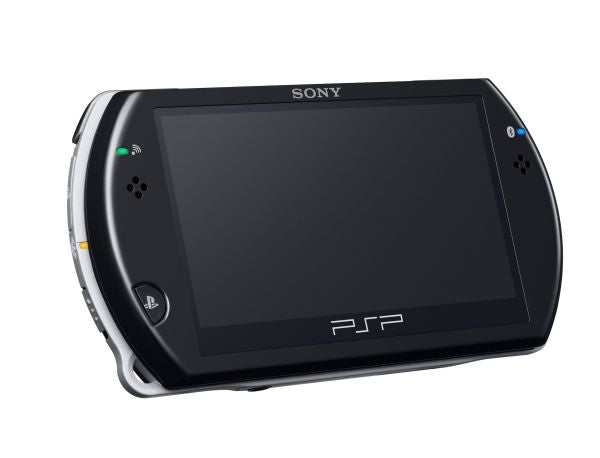
Verdict
Key Specifications
- Review Price: £199.00
If the PS3 Slim was Sony’s attempt to relaunch the PS3 and regain lost ground in the home console market, then the PSPgo represents the same for the PSP. Despite PSP sales of around 53 million, the last four years must have been galling for the house of PlayStation. The PSP never became ‘the next iPod’ as so many reviewers thought it would, and its UMD disc failed to take off as a next-generation media format. Instead, it was Nintendo’s strange, ungainly DS that caught the public imagination, outselling the PSP nearly 2-to-1. Worse, Apple’s iPhone/iPod touch has come from nowhere to become a third handheld gaming and media platform – arguably occupying the position of ‘all-in-one’ mobile entertainment device that Sony desperately wanted the PSP to grab. The PSPgo is Sony’s best hope at redressing that situation, and putting the PSP back in the game. 
As a physical redesign, the PSPgo has an awful lot going for it. The first and most obvious thing Sony has done is make it work a little like a slider mobile phone. When the device is switched off or when you’re just watching a movie or listening to some music, the controls are covered by the screen and the unit fits comfortably in one hand. Then, when you fancy a game, you slide the screen upwards to reveal the D-pad, analogue stick and face buttons.
The mechanism feels extremely solid, and this change has undeniable benefits. For one thing, it makes the PSPgo a more easily pocketable games machine – approximately 3mm shorter, 5mm slimmer and a whopping 47.4mm less wide than the old PSP3000, and 29g lighter too. As PMPs have grown smaller, even the slim PSP was beginning to feel like a large and rather cumbersome media player, and the PSPgo takes it right back into iPhone/iPod touch territory.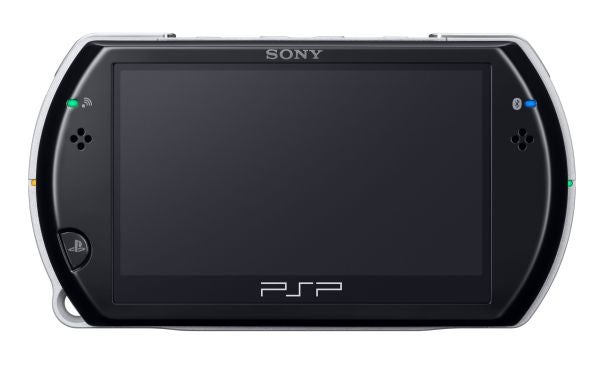
I’d also say that the new control layout is a definite improvement. The old position of the analogue stick never felt right, making my hand cramp up after long sessions, particularly in games like Resistance: Retribution where you’re making plentiful use of the L and R shoulder buttons. Now the stick falls pretty much where the left stick does on a dual-shock controller, and it feels more accurate and responsive to boot. The D-Pad and face buttons are smaller and more lightweight than they were on previous PSPs, but in use I can’t find any negative effects, and I even prefer the new metallic shoulder buttons over the old Perspex jobs. As far as conventional, non-touch-screen gaming goes, the PSPgo is easily the most ergonomically satisfying handheld games platform around.
The first downside of the redesign is that the screen has shrunk from 4.8in to 3.78in, with the resolution sticking at 480 x 272. This isn’t a disaster; this size/resolution combo works well for games and movie-watching, and this is actually the clearest, brightest PSP screen yet, with no sign of the weird heavy lines, interlacing issue that plagued the otherwise brilliant screen on the PSP 3000. The PSP was one of the few mobile media players – the iPod touch and the Archos 5 being other examples – where I have happily sat and watched whole films on it. I can comfortably say the same of the PSPgo. As a nice touch, the back of the case has two curved, rubberized ridges that should help hold the unit in place on a table or your knee while you’re travelling around.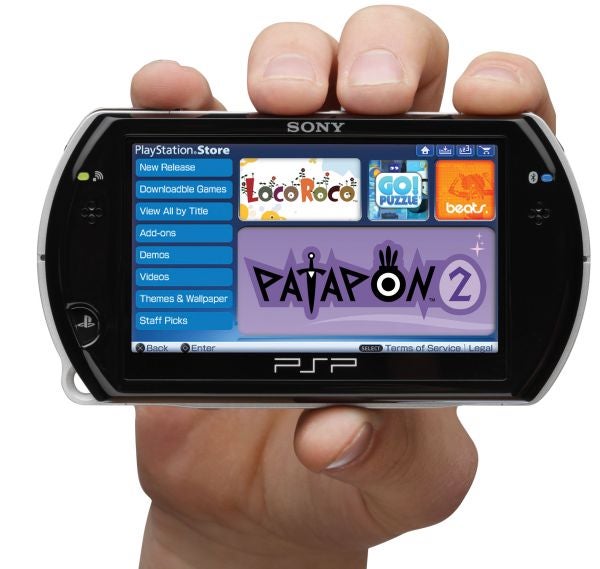
There are a handful of other changes. With less room on the face, the brightness, volume and sound buttons have been moved to a space between the shoulder buttons, leaving the home button the only real control left by the screen. The old mini-USB connector has been swapped for a proprietary socket, and you use the USB cable provided either with a PC or with the supplied USB charger to charge the unit. The optional AV cable now connects to this, and not a separate AV output socket.
The microphone and speakers remain, meaning the PSPgo will still operate as a Skype phone, and the PSPgo now supports Bluetooth 2.0 on top of 802.11b Wi-Fi, allowing you to hook up a headset or A2DP headphones if you have them (sadly, I don’t have a pair to test this out), or a PS3 controller, though you’ll need a PS3 to register the pad to the PSP. Be warned, meanwhile, that PSP accessories like the Go! Camera and Go Explore! GPS are incompatible with the new model.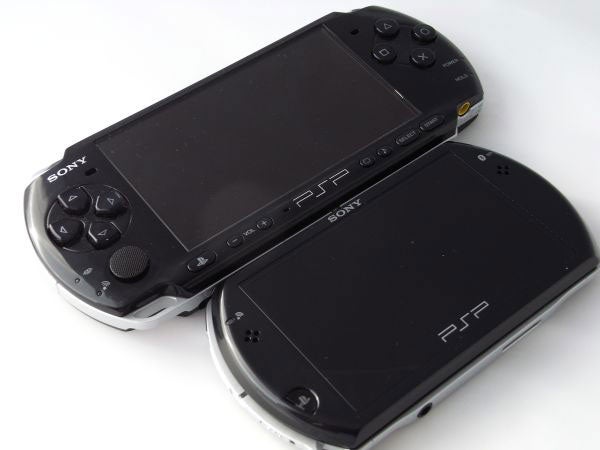
The next major change concerns storage. It came as no surprise when Sony decided to jettison UMD; movie industry support had grown embarrassing and, in terms of performance, power usage and price, a move to flash memory is the right idea. The PSPgo ships with 16GB of the stuff built in, with the idea being that you download all your games and media and store it on the PSP itself. I don’t think Sony has done itself any favours here by failing to find any way for existing PSP owners to transfer purchased games to the PSPgo, but otherwise this makes perfect sense.
Of course, there is a card slot to allow room for further expansion, but here Sony has shifted away from the old Memory Stick Pro Duo format to the Memory Stick Micro (M2) format. This annoyingly means you can’t use your old PSP memory sticks or transfer any content you’ve already downloaded or transferred, but – to be fair – M2 sticks seem to be slightly cheaper at the same capacity than the old format. I know most of us would prefer Sony to move with the rest of the consumer electronics industry to MicroSD but, let’s face it: that won’t be happening any time soon.
Like the iPod touch and most modern PMPs, the PSPgo uses an internal, non-replaceable Lithium-Ion battery, now rated at 960mAh over the PSP3000’s 1200mAh cell. The smaller screen size, the lack of UMD and some unspecified changes to the internal components mean that the PSPgo is more power efficient than its predecessor, but the lower capacity cell means that battery life is roughly the same. If you have a PSP you’ll know that it’s almost impossible to give solid figures on battery life, so much depends on screen brightness and the processing demands of the games you’re playing (God of War: Chains of Olympus and Gran Turismo use a lot more juice than the more basic titles). I’m getting around five hours of decent gaming or movie watching out of the PSPgo, which is around iPod touch levels, but not as good as Nintendo’s (rather less demanding) DS or DSi. 
With UMD gone, a lot depends on Sony’s online store. The first thing to note is that – in terms of firmware and software – the old and new PSPs are functionally identical. Anything you can download and play on the PSPgo, you can download and play on the PSP3000 or PSP2000, providing you have a memory stick with ample space. The second thing to note is that download speeds over the PSP’s built-in Wi-Fi are painfully slow; anyone with any sense will hook up their PSPgo to a PC and purchase, download and transfer titles using the supplied Media Go application. As this also provides brains-free video conversion and music transfer, this is one of the few bundled media management apps that will actually see active use.
At the time of writing, the software line-up is respectable and growing, with major recent releases like Gran Turismo, MotorStorm: Arctic Edge, Need for Speed: Shift and FIFA ‘10 all onboard. There are still some inexplicable absences – no God of War: Chains of Olympus or Dissidia: Final Fantasy, for example – but classics like WipEout Pulse, LocoRoco2, Ridge Racers 2 and Ratchet and Clank: Size Matters can easily be found.
For all the talk about the huge range of games on the DS or the vast library on Apple’s app store, it’s still worth remembering that – when it comes to producing mobile versions of what you might call traditional console games – the PSP remains unchallenged. Sure, Firemint’s Real Racing on the iPod Touch is great, but Gran Turismo looks significantly more impressive and – with physical, analogue controls – offers a more enjoyable and accessible drive. MotorStorm: Arctic Edge and WipEout Pulse leave any iPhone or DS rivals in the dust, and only a fool would even compare any iPhone action game to Chains of Olympus or Ratchet and Clank.
That said, Apple does offer one thing that, up until now, the PSP has not: cheap and cheerful, impulse purchase games. Sony’s PSP Minis range, launching with the PSPgo, is Sony’s attempt to do something about that. Of the thirteen titles currently available, selling for between £2.49 and £3.99, there are a couple of gems (iPhone tower defence classic, Fieldrunners, the Lemmings meets LittleBigPlanet antics of Kahoots and a superb conversion of the Amiga classic Pinball Fantasies), some decent puzzle efforts (Breakquest and Vempire) and a few real clunkers (that awful iPhone b-movie God of War clone, Hero of Sparta).
Sony has already fared better here than Nintendo with its disappointing DSiWare range, but it still needs more games, and cheaper games, if it wants to go toe to toe with our chums from Cupertino. What’s more, a drop in prices for regular games wouldn’t go amiss. I understand that Sony doesn’t want to annoy conventional game retailers, but should it really be £3 cheaper to buy GT on UMD from Amazon than buy it from Sony’s own online store?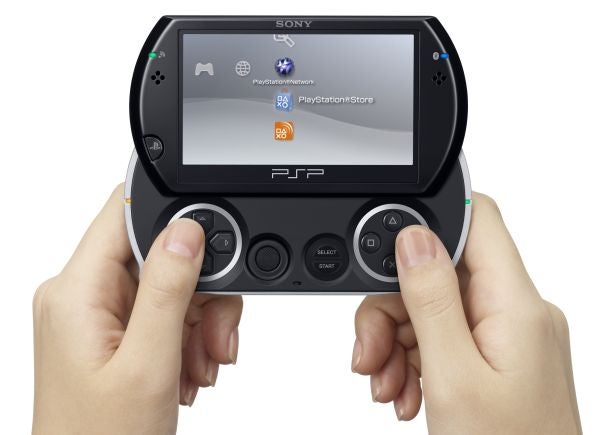
So, is the PSPgo worth buying? Well, there are some niggles and some legitimate reasons why new or existing PSP owners might prefer to stick with the PSP3000. For one thing, any software you already have on UMD will carry on working. For another, you can keep a spare battery or use a third-party high-capacity battery for longer trips. However, in nearly all other respects this is not just the best PSP yet, but a mobile games machine and media player. Sony still needs to convince us that a steady supply of decent games is on its way – two or three great titles a year just isn’t good enough – but the PSPgo should have made a great platform to relaunch with.
But now we come to the elephant that’s been sitting quietly in a corner of the room for all this time: price. Had Sony brought in the PSPgo at £150 to compete with the 8GB iPod touch and DSi, I’d be almost as keen to recommend it as I am the PS3 Slim. Sadly, even when you factor in the 16GB of onboard flash memory the £225 RRP is absolutely baffling. This isn’t an entirely new product with new capabilities, improved graphics and a next-generation line-up of games; it’s a revision of a handheld that’s over four years old, and it really should have been priced accordingly.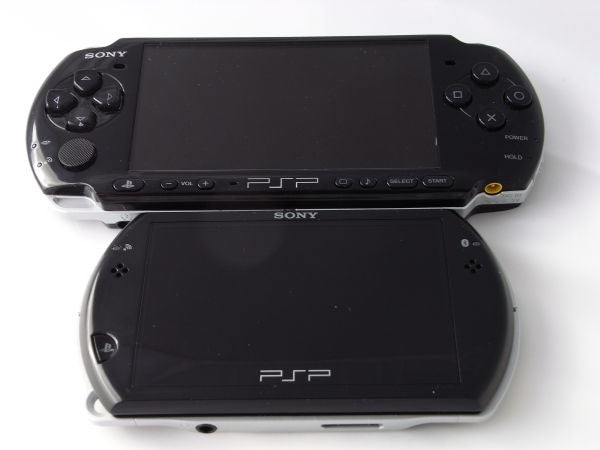
Even at the £199 price point that most online retailers are selling it for, the PSPgo is only just in the realms of decent value. When you consider that you can buy a near-functionally identical PSP3000 for £130 and two 8GB Memory Stick Pro Duo cards for under £40 if you shop around, the PSPgo looks even worse. While Sony’s engineers have taken aim and mostly hit the target, the executives in charge of pricing have shot the product squarely in the foot. High pricing nearly killed the PS3, so why has Sony decided to make the same mistake with the PSPgo?
Should someone see sense and the price come down in the future, then the PSPgo is definitely worth a second look. As I mentioned, Sony still has a lot to prove in terms of software, but this is a great bit of hardware for playing games on, and one that makes even more sense should you also opt for a PS3. Priced as it is, however – and even with the £199 online price – you’d have to be either very wealthy or really very silly to dump that kind of cash. It’s a great handheld, but just not worth that kind of money.
”’Verdict”’
A highly successful hardware redesign backed up by improving services and software. Sadly, the PSPgo still can’t justify Sony’s sky-high price tag.

